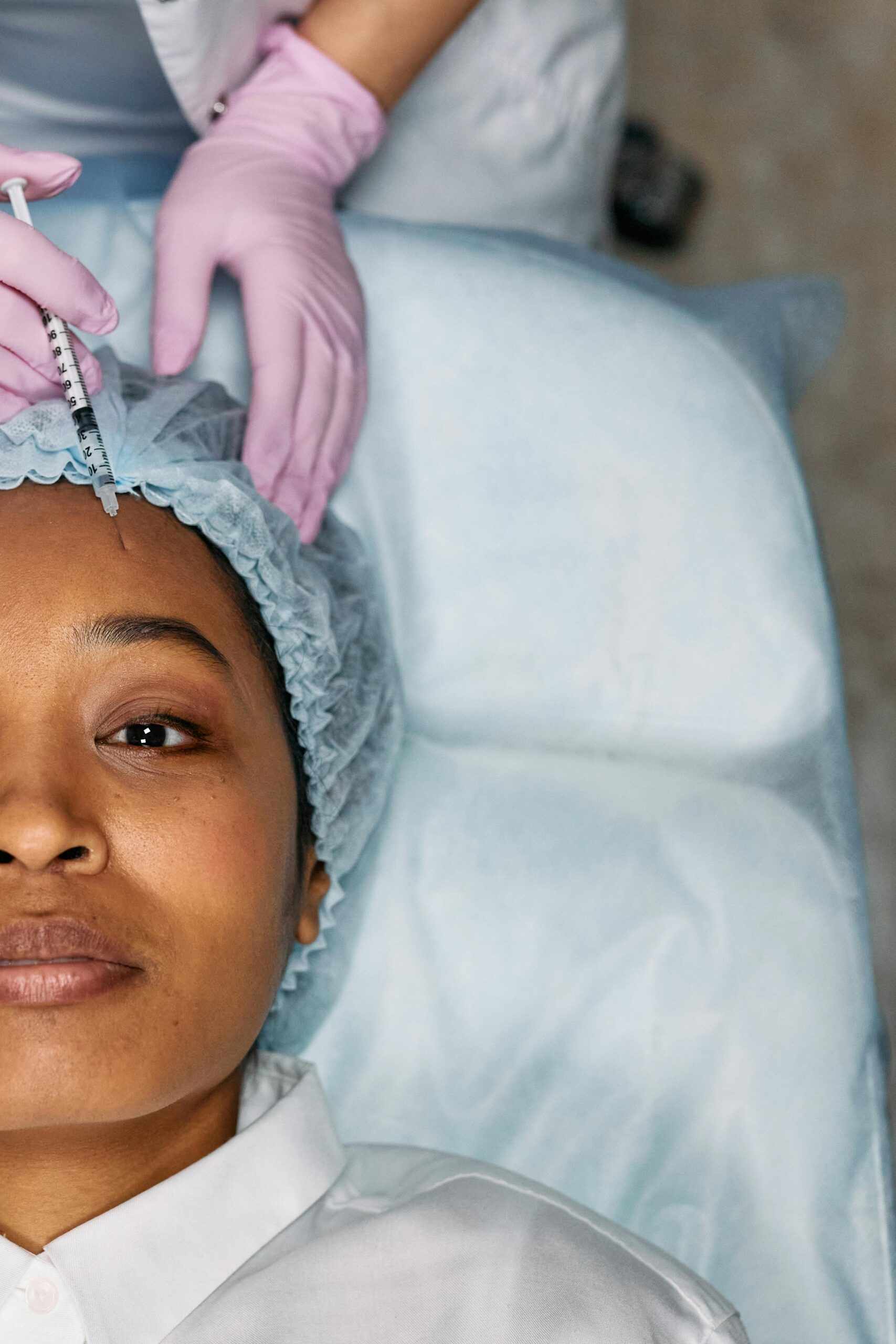Are you feeling self-conscious about your appearance due to a high forehead? Discover the transformative power of forehead reduction surgery! This innovative cosmetic procedure can help you achieve a more balanced and harmonious facial profile, boosting your confidence and self-esteem. Many people wonder, “Is forehead reduction surgery right for me?” If you’ve been considering a change, you’re not alone; this trending surgery has gained popularity among those seeking to enhance their features. With the right techniques, a skilled surgeon can significantly reduce the size of your forehead, giving you a more youthful and attractive look. Imagine stepping out with newfound confidence, knowing your appearance reflects how you truly feel inside. But what should you expect during the forehead reduction surgery recovery process? Understanding the benefits and potential risks is crucial in making an informed decision. In this blog post, we will explore everything you need to know about forehead reduction surgery, from the procedure itself to post-operative care. Stay tuned to uncover the secrets of this life-changing cosmetic enhancement, and learn how to embrace your beauty with confidence!
5 Life-Changing Benefits of Forehead Reduction Surgery You Didn’t Know About
Forehead reduction surgery, also known as hairline lowering, has become increasingly popular among individuals seeking to reshape their foreheads and enhance their facial harmony. This procedure involves removing a portion of the forehead skin and repositioning the hairline, which can lead to significant aesthetic changes. However, many people are unaware of the deeper benefits this surgery can provide, beyond just a shorter forehead. Let’s explore the five life-changing benefits of forehead reduction surgery that you might not know about.
1. Boosting Self-Confidence
One of the most profound impacts of forehead reduction surgery is the boost in self-esteem it can provide. Many individuals with larger foreheads feel self-conscious, often leading them to avoid social situations or photo opportunities. By opting for this surgical procedure, many patients report feeling more confident in their appearance. It’s not just about reducing the forehead size; it’s about feeling good in one’s skin. A smaller forehead can be a catalyst for someone to embrace their looks, leading to improved social interactions and personal relationships.
2. Enhanced Facial Proportions
Forehead reduction surgery helps in achieving better facial symmetry. The proportions of the face play a crucial role in overall aesthetics. A larger forehead can sometimes throw off the balance, making other facial features appear less appealing. The surgery adjusts the hairline and can create a more harmonious look. For instance, if someone has a prominent chin or cheekbones, a smaller forehead can help in drawing attention to these features instead. Patients often express satisfaction in how their overall appearance improves, making it a worthwhile consideration for many.
3. Long-Lasting Results
Unlike some cosmetic procedures that require frequent touch-ups or maintenance, forehead reduction surgery offers long-lasting results. Once the hairline is repositioned, it stays in place, and the results can last for many years. This permanence is appealing for those who desire a stable change without the hassle of ongoing treatments. It can be seen as an investment in one’s appearance that pays off in the long run. Additionally, the advancements in surgical techniques mean that patients typically experience minimal scarring.
4. Psychological Benefits
Many studies indicate that cosmetic surgery can lead to psychological improvements. Forehead reduction surgery can reduce feelings of anxiety or depression related to body image issues. Patients often find that after surgery, they feel more positive and less critical of their appearance. This mental shift can lead to a more fulfilling life with better personal and professional interactions. The psychological benefits can be profound, helping individuals pursue opportunities they may have previously shied away from.
5. Tailored Surgical Options
One of the lesser-known aspects of forehead reduction surgery is the range of techniques available. Surgeons can tailor the procedure to fit individual needs, whether it’s a minor adjustment or a more significant alteration. Options include:
- Direct Hairline Advancement: This technique pulls the hairline forward.
- Brow Lift: Sometimes combined with forehead reduction, this lifts the brow area for an overall rejuvenated appearance.
- Scalp Expansion: In some cases, tissue expansion can be used to lower the hairline effectively.
Having multiple options allows patients to work closely with their surgeons to find what best suits their needs and goals. This personalization can greatly enhance satisfaction rates post-surgery.
Important Considerations
Before considering forehead reduction surgery, it’s essential to keep several factors in mind:
- Recovery Time: Patients usually need a few weeks to fully recover, but many can return to light activities within days.
- Cost: Like many cosmetic procedures, costs vary widely depending on the surgeon’s expertise and the complexity of the procedure.
- Consultation: A thorough consultation with a qualified surgeon is crucial for understanding potential risks and realistic outcomes.
Summary
Forehead reduction surgery can be more than just cosmetic; it’s a transformative journey that can lead to enhanced self-confidence, improved mental health, and a more balanced appearance. With various techniques available, patients can find a solution that best fits their individual needs. Many who undergo this procedure find themselves not only looking different but feeling different in the most positive ways. It’s a choice that can lead to a brighter, more confident future.
Is Forehead Reduction Surgery Right for You? 7 Key Factors to Consider
Considering forehead reduction surgery? You’re not alone. Many peoples look for ways to feel better about their appearance. This procedure can help create a more balanced facial look by reducing the size of the forehead. But is it the right choice for you? Here’s seven key factors to consider before making a decision.
1. Understanding the Procedure
Forehead reduction surgery, also called hairline lowering surgery, involves moving the hairline downwards. This is usually done by removing a strip of skin from the forehead, and then pulling the scalp down to close the gap. The results can be dramatic, and people often report feeling more confident after the surgery. However, it’s important to understand what the procedure entails.
- Surgical Time: The operation typically takes 2 to 3 hours.
- Anesthesia: Patients usually receive general anesthesia.
- Recovery: Most people can return to normal activities within a week but may need to avoid strenuous activities for a month.
2. Your Hairline and Forehead Size
One important factor is your current hairline and overall forehead size. If your forehead is significantly larger than average, forehead reduction surgery might be a good option. However, if you have a normal-sized forehead, you may want to think twice. Sometimes, the perception of a large forehead can stem from other facial features, like a weak chin or prominent cheekbones.
3. Age and Skin Elasticity
Age plays a role in how well you might heal from surgery. Younger patients often have better skin elasticity, which could result in a smoother recovery. Older patients might not see the same results because skin becomes less elastic with age. Here’s a quick breakdown:
- Under 30: Generally good candidates, better healing.
- 30-50: Might need to consider elasticity.
- Over 50: Consult with a surgeon about expectations.
4. Medical History
Your medical history is crucial. Certain health conditions, like diabetes or heart problems, can complicate surgery. It’s essential to discuss any existing conditions with your surgeon. Some factors to consider include:
- Previous Surgeries: Have you had any facial surgeries before?
- Medications: Are you taking blood thinners or other medications that can affect healing?
- Allergies: Any allergies to anesthesia or medications?
5. Psychological Readiness
Having realistic expectations is important. Some people seek forehead reduction surgery to boost self-esteem, while others might do it for societal pressures. It’s important to be mentally prepared for the changes, and to understand that surgery won’t solve all personal issues. Consider asking yourself these questions:
- Why do you want the surgery?
- Are you prepared for the recovery process?
- Can you afford the procedure, both financially and emotionally?
6. Finding the Right Surgeon
Choosing the right surgeon can make all the difference. Look for board-certified plastic surgeons with experience in forehead reduction. Check out reviews, before-and-after photos, and ask for referrals if needed. Here’s a checklist for when you’re researching surgeons:
- Board Certification: Verify their credentials.
- Experience: How many surgeries have they performed?
- Consultation: Do they spend enough time explaining the procedure?
7. Cost Considerations
Forehead reduction surgery can be expensive. Costs can vary significantly based on location, surgeon experience, and facility fees. Here’s a rough estimate of what you might expect to pay:
- Average Cost: Between $3,000 to $7,000.
- Insurance: Most insurance plans do not cover cosmetic procedures, so check your policy.
- Financing Options: Look for clinics that offer payment plans or financing.
Deciding to undergo forehead reduction surgery is a personal choice that requires careful thought. It’s not just about changing your appearance; it’s about enhancing your confidence and feeling good in your skin. If you’re considering this procedure, weigh these factors carefully. Consulting with a professional can also help clarify your options. Remember, looks can change, but feeling good about yourself is what truly matters.
Forehead Reduction Surgery Recovery: 10 Tips for a Smooth Healing Journey
Forehead reduction surgery, also known as hairline lowering or forehead contouring, has became increasingly popular among individuals who desire to enhance their facial proportions. This procedure aims to shorten the forehead and create a more balanced appearance, ultimately boosting self-esteem and confidence. However, undergoing forehead reduction surgery is just the first step; the recovery process can be equally important. Here’s ten practical tips to help you navigate through your healing journey and ensure a smooth recovery.
1. Follow Your Surgeon’s Instructions
Every surgeon has their own set of instructions for post-operative care. It’s crucial to carefully follow these guidelines. They may include specific medications, dietary restrictions, and activity limitations. Ignoring these could lead to complications, which you surely want to avoid.
2. Manage Swelling and Bruising
Swelling and bruising are common after forehead reduction surgery. To ease these side effects, consider these strategies:
- Apply ice packs wrapped in a cloth to the forehead for the first 48 hours.
- Elevate your head while sleeping for the first week.
- Avoid strenuous activities and bending over, which can exacerbate swelling.
3. Keep the Incision Site Clean
Maintaining cleanliness around the incision area is vital for preventing infections. Gently clean the area with mild soap and water as directed by your surgeon. Avoid soaking in baths or swimming until cleared by your doctor.
4. Stay Hydrated and Nourished
Proper nutrition and hydration supports your body’s healing process. Drink plenty of water and include nutrient-rich foods in your diet, like fruits, vegetables, and lean proteins. Foods rich in vitamin C, like oranges and strawberries, can help to boost your immune system.
5. Take Prescribed Medications
Your surgeon likely prescribes pain medications and antibiotics to manage discomfort and prevent infections. It’s important to take these medications as directed. If you experience any adverse reactions, contact your doctor immediately.
6. Plan for Time Off
Recovery can vary from person to person, but generally, taking at least a week off work is recommended. It’s essential to give yourself ample time to heal without the distractions of work or other responsibilities. Use this time to rest and focus on self-care.
7. Avoid Strenuous Activities
For the first few weeks post-surgery, avoid heavy lifting, vigorous exercise, or anything that puts strain on your body. This is crucial for preventing complications and ensuring optimal healing. Light walking can be beneficial, but listen to your body and don’t overdo it.
8. Monitor for Complications
Keep an eye out for any signs of complications, such as excessive bleeding, severe pain, or unusual discharge from the incision site. If any of these occur, it’s important to seek medical attention right away. Early intervention can prevent more serious issues.
9. Prepare for Emotional Changes
It’s not uncommon to experience a range of emotions during recovery. You may feel excited about your new look, but also frustrated with the healing process. Surround yourself with supportive friends and family who can help you through any emotional ups and downs.
10. Follow Up with Your Surgeon
Attend all scheduled follow-up appointments with your surgeon. These visits are essential for monitoring your healing progress and addressing any concerns you may have. They can provide additional advice and reassurance throughout your recovery journey.
Transform Your Look With Confidence
Forehead reduction surgery is more than just a cosmetic procedure; it’s a means to transform your look and enhance self-confidence. Understanding what to expect during the recovery phase can help you feel more prepared and less anxious. Make sure to do your research and consult with professionals before making any decisions.
In addition to the physical changes, the emotional aspects of adjusting to your new appearance can be significant. You might find yourself feeling more confident and ready to take on new challenges. Just remember, healing takes time, and it’s perfectly normal to have good days and bad days. With these tips in hand, you can ensure a smoother recovery and embrace the new you with open arms.
Before and After: Real Stories of Confidence Boost from Forehead Reduction Surgery
Forehead Reduction Surgery is gaining popularity among individuals seeking to enhance their appearance and boost their confidence. Many people felt insecure about their foreheads, which they believed were too large or disproportionate to their facial features. This surgery can dramatically change one’s look, leading to newfound confidence. Here, we will explore real stories of individuals who underwent this procedure, the impact it had on their lives, and what potential candidates should know.
What is Forehead Reduction Surgery?
Forehead Reduction Surgery, also known as hairline lowering surgery, involves surgically removing excess forehead skin and lowering the hairline. This procedure not only reshapes the forehead but also can enhance facial balance. It often appeals to men and women who have a high hairline or a longer forehead.
Key Benefits of Forehead Reduction Surgery:
- Enhances facial proportion
- Decreases forehead size
- Improves hairline appearance
- Boosts self-esteem
The Procedure: What to Expect
The surgery is typically performed under local or general anesthesia and can take about two to four hours. The surgeon makes incisions along the hairline, removes a strip of skin, and pulls the skin down to create a lower hairline. After that, stitches are used to close the incisions. Recovery time can vary but usually takes a week or two, with most people returning to their daily activities soon after.
Real Stories: Before and After Transformations
Let’s look at some real stories from individuals who have undergone this surgery. Their experiences highlight how impactful such a procedure can be.
Jessica, 29: From Insecure to Empowered
Before: Jessica always felt her forehead was too large. She avoided photos and felt self-conscious in social settings. “I thought I looked strange, like an alien,” she said.
After: Post-surgery, Jessica felt transformed. “I can wear my hair back and not worry. I feel amazing,” she explains. The confidence boost allowed her to pursue new opportunities at work and even start dating again.
Mark, 34: A New Lease on Life
Before: Mark had struggled with bullying due to his prominent forehead during his teenage years. He carried this insecurity into adulthood, often wearing hats to hide his forehead.
After: After the surgery, Mark noticed a significant improvement in his self-image. “I finally feel normal. I can walk into a room without thinking about my forehead,” he shared. His newfound confidence has led him to engage more socially and take on leadership roles at work.
Who is an Ideal Candidate?
Not everyone is suited for forehead reduction surgery. Here are some factors to consider:
- Age: Most candidates are adults, but teenagers can consider it if their facial structure has stabilized.
- Health: Good overall health is essential. Those with certain medical conditions may not be ideal candidates.
- Expectations: Candidates should have realistic expectations and a clear understanding of the procedure.
Comparing Forehead Reduction to Other Cosmetic Surgeries
When considering cosmetic surgery, it’s helpful to compare options. Here’s a table with some common procedures related to forehead area enhancement:
| Procedure | Purpose | Recovery Time |
|---|---|---|
| Forehead Reduction | Lowers hairline, reduces forehead size | 1-2 weeks |
| Brow Lift | Raises sagging brows, smooths forehead | 1-2 weeks |
| Botox for Forehead Lines | Reduces wrinkles and fine lines | Few days |
| Hair Transplant | Fills in thinning hair areas | 1-2 weeks |
Practical Considerations
If you’re considering forehead reduction surgery, here are some practical tips to keep in mind:
- Research: Investigate surgeons and read reviews from previous patients.
- Consultation: Book a consultation to discuss your goals and ask questions about the procedure.
- Budget: Understand the costs involved, which can vary widely based on location and surgeon experience.
- Aftercare: Follow post-operative care instructions closely for the best results.
Forehead reduction surgery can be a life-changing decision for many individuals. The stories of people like Jessica and Mark highlight the confidence boost that can come from transforming one’s appearance. As with any cosmetic procedure, it’s essential to weigh the benefits and risks carefully. For those who feel that a larger forehead impacts their self-esteem, this surgery might just be the key to unlocking a more confident self.
Expert Insights: What to Expect During Your Forehead Reduction Surgery Consultation
Forehead reduction surgery is becoming more popular among those looking to reshape their appearance and boost confidence. If you are considering this procedure, knowing what to expect during your consultation can help you feel prepared and informed. Here, we explore the ins and outs of forehead reduction surgery consultations, giving you the expert insights needed for a smooth experience.
What is Forehead Reduction Surgery?
Forehead reduction surgery, also known as hairline lowering surgery, involves lowering the hairline and reducing the forehead’s size. It can be performed for cosmetic reasons, or for functional reasons, like if someone has a high forehead that causes discomfort. The procedure is typically done under local anesthesia, and recovery times can vary.
A few key points about forehead reduction surgery include:
- Target Audience: Ideal for individuals with a high hairline or an overly prominent forehead.
- Techniques Used: Surgeons may employ different surgical techniques, including skin excision and scalp advancement.
- Recovery: Most patients can return to daily activities within a week, but full recovery may take several weeks.
Preparing for Your Consultation
Before your forehead reduction surgery consultation, you should gather important information to discuss with your surgeon. This includes your medical history, any medications you are taking, and your expectations for the surgery. Here’s a checklist to help you prepare:
- List of medical conditions
- Current medications
- Photos of desired forehead appearance
- Questions for the surgeon
During the consultation, your surgeon will evaluate your forehead size, hairline, and facial structure to recommend the best approach. They might also discuss potential risks and complications, which can include scarring, asymmetry, or infection.
Questions to Ask During the Consultation
It’s crucial to ask the right questions to feel confident in your decision. Here are some suggestions:
- What is your experience with forehead reduction surgery?
- What kind of results can I realistically expect?
- Can I see before and after photos of previous patients?
- What are the risks and complications associated with this surgery?
- How long will the recovery period be, and what will it involve?
Understanding the Procedure
Forehead reduction surgery usually involves several steps. Here’s a basic outline of what to expect:
- Anesthesia: Local anesthesia is administered to numb the area.
- Incision: A horizontal incision is made along the hairline to remove excess skin.
- Scalp Advancement: The scalp is then moved forward to lower the hairline.
- Closure: The incision is closed with stitches or staples, which will be removed in about a week.
Post-Operative Care
Following the surgery, you will receive specific post-operative care instructions. This can be a bit overwhelming, but it’s important to follow them closely to ensure a smooth recovery. Some common care tips include:
- Apply ice packs to the forehead to reduce swelling.
- Take prescribed pain medications as directed.
- Avoid strenuous activities for at least a few weeks.
- Attend follow-up appointments for monitoring.
Risks and Considerations
While forehead reduction surgery is generally safe, like all surgical procedures, it carries potential risks. Some to consider are:
- Scarring: While surgeons aim to place incisions in less visible areas, scars can still form.
- Changes in sensation: Some patients report altered sensation in the forehead area post-surgery.
- Hair loss: A risk of hair loss in the area where incisions are made can occur.
Expert Insights
Experts suggest that you should choose a board-certified plastic surgeon with experience in forehead reduction surgery. This will greatly increase your chances of achieving the desired results. Look for someone who has a good track record and can provide testimonials from previous patients.
Transform Your Look With Confidence
Forehead reduction surgery can be a life-changing decision that enhances your features and boosts self-esteem. Knowing what to expect during the consultation is crucial. The more informed you are, the easier it will be to navigate through the process.
Remember, communication is key; be open with your surgeon about your expectations and concerns. This way, you are more likely to achieve the transformation you desire. With the right preparation and understanding, you can approach your forehead reduction surgery consultation with confidence, ready to embrace the changes ahead.
Conclusion
In conclusion, forehead reduction surgery offers a transformative solution for individuals seeking to achieve a more balanced facial appearance by minimizing an excessively high forehead. Throughout this article, we’ve explored the various aspects of the procedure, including the surgical techniques involved, potential risks and benefits, and the significance of selecting a qualified surgeon for optimal results. It’s essential for prospective patients to have realistic expectations and to engage in thorough consultations to address any concerns. As with any cosmetic procedure, the decision to undergo forehead reduction surgery should be made carefully, considering both the aesthetic desires and the potential impact on self-esteem. If you believe this surgery could enhance your confidence and overall appearance, we encourage you to seek personalized advice from a trusted medical professional. Embrace the opportunity for a new beginning and take the first step towards the look you’ve always desired.














